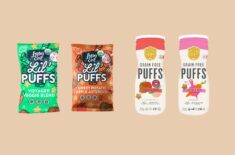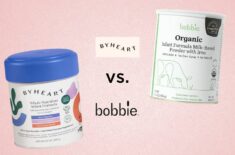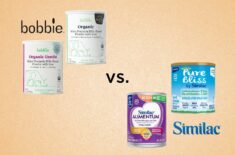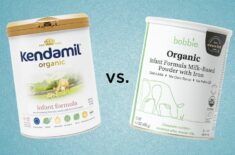When Should My Baby Start Using Utensils?
You can introduce your baby to utensils when they begin eating solid foods, but they aren’t likely to be interested in using them at first.
Utensil use is an important milestone, but timing and readiness depend on your unique baby’s development progress. And because babies develop at varied rates, they don’t start using utensils at the same age.
Check for signs of readiness for utensil use before offering them a spoon for the first time. It’s not a good idea to force your baby to use utensils if they just ignore, play, or throw them. You don’t want to create negative associations with mealtimes, especially early on.
We recommend starting off with the spoon, then, once mastered, moving on to the fork. Lastly, you can introduce a knife with care and lots of supervision.
There’s no need to worry because sooner or later, your little one will eventually learn to use utensils when they’re ready.
How Do I Introduce My Baby’s Utensils?
At first, your child might not understand the need for utensils. Babies don’t need to use utensils straight away, so don’t expect them to master this skill the first time they eat solids.
It’s perfectly fine to allow them to use their hands. Spoons are usually the first utensil to be introduced, and you can start off by preloading the spoon and handing it to your baby.
Starting With Finger Feeding
If your child doesn’t appear interested in utensil use, that’s fine. Start with finger foods or you can also do baby-led weaning.
Baby-led weaning is a methodology that allows your baby to practice grasping and coordinating their movements to put food in their mouth.
You might notice your child raking their food with their fingers and using their entire palm to hold it. That’s a good start.
At this stage, when they first start eating, finger feeding is easier than utensil use.
Finger feeding also helps your baby develop and master hand-eye coordination, an important skill needed for eating and other life skills.
Picking The Right Time
Most babies are observant and curious about what other people are doing.
If they share your mealtimes, they might show interest in utensils because they see everyone else is using them.
Begin offering your child utensils when they show interest or readiness to use them.
Starting Them Early
Still, even if they aren’t interested in utensils, you can start them early by giving them a spoon to hold during mealtimes.
Curious toddlers are likely to pick it up and try to dig into their food bowl. You can also preload the spoon and let your baby feed themselves.
Teaching Your Child To Use Utensils
How To Teach Your Toddler To Use A Spoon
Preloading The Spoon (Or A Pre-spoon)
Many parents find it easier to preload the spoon or pre-spoon with food and let their baby pick it up. At first, babies might struggle to move the spoon and put the food in their mouths.
They’ll soon get the hang of it with lots of practice, so don’t worry, mama.
Trying The Hand-Over-Hand Method
The hand-over-hand method is another effective way of teaching your baby to use a spoon.
Put your hand over your child’s hand, and gently guide them in scooping their food and slowly moving the spoon to their mouth.
Practice Self-Feeding
Another option is to give your baby the spoon and let them copy your movements while you model with your spoon.
How To Teach Your Toddler To Use A Fork
You can use the same methods above in training your baby to use a fork.
However, due to the design (sharp tips), it’s important to take extra precautions before introducing a fork to your little one so they don’t accidentally injure themselves.
First, choose forks made of soft material, such as silicone, to reduce the risk of your child getting hurt by the prongs (the sharp, pointed parts at the end of the utensil).
Second, ensure your child has mastered hand-eye coordination to avoid movements that could bring the fork to their eyes.
Third, check that the pieces of food can be easily picked up by the prongs and won’t fall off while they move the fork to their mouths.
The fork can be trickier to wield than the spoon because of their tiny hands, but your toddler will soon get the hang of it with lots of practice.
How To Teach Your Little One To Use A Cup
We recommend skipping the sippy cup and offering a regular, child-sized cup instead. Sippy cups can affect your baby’s speech development. (1)
Still, take care when introducing a cup to your child, especially if they still don’t have full hand control.
Start with a small amount of water in the cup.
Let your child hold the cup, but gently guide their hands while drinking.
If they’re having a difficult time with this, you can give them a nearly full cup but make sure you’re in control to avoid getting water in their nose.
With lots of practice, your baby will soon learn to drink without your assistance.
Keep at it, and be ready for some wet times ahead while they’re learning.
How To Teach Your Toddler To Use A Knife
Once your child has mastered the utensils above, they can start learning how to use a knife. You can use the same steps to teach them how to use a spoon.
How Do I Teach My 1-Year-Old To Use Utensils?
Because they’re older, probably have lots of practice eating finger foods, and have possibly developed their fine motor skills, 1-year-olds might have an easier time with utensil use than younger children.
You can follow the process we detailed above to teach your 1-year-old how to use utensils. It might even be alright to skip preloading the spoon because they’re likely able to scoop the food from their bowl or plate without help.
Dealing With The Mess
Yes, mama, mealtimes can be messy, especially when your toddler is still learning to feed themselves.
Clean-ups can be easier by letting your baby use helpful items like Bibado bibs and putting sheets under their high chair.
Practice Using Utensils Even During Playtime
Children learn a lot through play. So, you can let them play with child-safe utensils (spoons, plates, and cups) with pretend food.
It helps improve their hand-eye coordination and fine motor skills.
Stay Patient
Your baby isn’t likely to learn utensil use immediately, but with lots of practice (and lots of messes), they’ll eventually get it right. It’s best to stay patient as they develop their feeding skills.
Be The Role Model For Good Table Manners
Kids are quite observant. You and the rest of the family are your baby’s role models for learning good table manners.
Because they’re so observant, babies are likely to copy how you use utensils.
Praise & Encourage Your Baby’s Efforts
Let your baby know that you’re proud of how they’re learning to use their utensils properly.
By praising and encouraging their efforts, your baby will likely feel more eager to keep trying until they finally learn how to use utensils properly.
Choose The Best Foods For Learning How To Use Utensils
Pick foods that can be easier for your baby to scoop with their spoon or stab with a fork.
SAFETY WARNING: Prepare your baby’s food into age-appropriate and bite-sized pieces to reduce choking risks.
Spoon-friendly Baby Foods
- Mashed avocados or guacamole
- Mashed potatoes
- Mashed sweet potatoes
- Thick purées or soups
- Oatmeal
- Hummus
Fork-friendly Baby Foods
- Soft fruits like ripe mangoes, melons, or bananas
- Pancake squares
- Pasta shells
- Whole grain toast squares
Things To Consider Before You Introduce Utensils
Determining Your Child’s Readiness For Solid Foods & Utensils
Before introducing spoons and forks, it’s important to first check if your baby is ready for solid foods (especially if they’re younger than four months).
Consult your pediatrician and get the go-signal before giving them solid food for the first time.
Babies are still trying to learn how to use their hands or coordinate movements (hand-eye coordination) around the time they start solid foods.
Offering utensils early is okay; however, don’t expect them to master this skill immediately.
You can help your little one learn how to grasp a spoon by choosing one with a rounded, short handle. This is because young children first learn to hold food or utensils using the palmar grasp (curling their entire palm around the handle).
Spoons with this design include Bumkins Silicone Chewtensils and UpwardBaby BLW Feeding Supplies.
Signs of Readiness
- Shows curiosity about silverware used by adults and older children during mealtimes
- Tries to scoop food from their bowl or plate
- Spoon-fed babies grab preloaded spoons and try to feed themselves.
Baby’s Development Milestones Required For Utensil Use
- Maintains an upright sitting position throughout the meal
- Chews, swallows, and gets ready for the next bite
- Independently holds a spoon, cup, or other utensils
- Fine motor skills for scooping baby food
- Hand-eye coordination for moving the spoon (or pre-spoon) from the bowl or plate to their mouth
Creating A Practice Area With Your Toddler
- Choose a distraction-free area and avoid letting your child use a gadget or watch TV while eating.
- Pick a comfortable, safe high chair with a wide tray.
- Spread garbage bags or plastic mats on the floor to catch the mess
- Try to pick spill-proof cups and bowls with suction bottoms to protect against spills.
- Create space at your dining table for your baby.
Start Simple & Do It One At A Time
While your baby might appear interested in different cutlery, introduce them one at a time. They’re still learning to coordinate their movements, so using both hands for two different utensils might confuse them. Spoons are usually the easiest and safest to introduce.
Which One Should I Introduce First: A Spoon Or Fork?
It’s best to introduce spoons first, especially from a safety standpoint. They’re smooth, round, and don’t have potentially sharp prongs like the fork.
By starting with the spoon, your baby learns how to use cutlery with a reduced risk of accidentally stabbing their eyes, sensitive gums, or other body parts.
Getting The Right Utensils
Main Safety Features To Consider
No matter what utensil you’re trying to pick, these are the basic safety features to consider:
Soft
Your baby’s soft gums are sensitive and more prone to getting cuts from hard objects, such as silverware and stainless steel utensils. Even plastic utensils can also injure your baby’s gums.
Soft utensils made of silicone are the best choice. They’re soft and less likely to hurt your baby.
Baby-Safe Materials (Plastic-Free & BPA-Free)
Any utensil that comes in contact with your baby’s food, hands, and mouth should always be safe and free from toxic chemicals.
Avoid anything that contains BPA (bisphenol-A), phthalates, AZO dyes, and PVC (polyvinyl chloride).
Always check for potential safety risks in the utensils’ design.
Smaller In Size Than Regular Utensils
Regular utensils can be too big and too heavy for babies. Get baby-sized utensils that can fit their mouth and aren’t too heavy to use independently.
Check For Product Recalls
Always check for safety alerts and product recalls for each baby product you’re planning to buy or your baby is already using.
Choosing Plates & Bowls
Silicone and stainless steel plates or bowls are preferable because they’re less likely to have toxic chemicals that can leach into your baby’s food.
It’s also good to pick plates and bowls with a suction base to avoid spills and keep them in place.
Some options you can try:
- Ahimsa Balanced Bites Stainless Steel Plates
- Loulou Lollipop Silicone Suction Snack Plate
Choosing Cups
Cups with a topple-resistant base are ideal for babies to help reduce spills.
It’s also important to pick tiny cups that are narrow enough so your baby’s little hands can hold them without assistance.
Cups you can try:
- Munchkin Miracle 360 Trainer Cup
- EZPZ Tiny Cup
Choosing Bibs
Picking the right bib can help minimize messes during mealtime.
Some options you can try:
- Bibado Long-sleeve Coverall Weaning Bib
- BabyBjörn Baby Bib
- Happy Healthy Parent E-Z-Clean Silicone Bib
Choosing The Best Spoons & Forks By Your Baby’s Age
For 4 to 6 Months+
- Smaller spoons with soft silicone tips
- Prespoons with a flat tip
- Shorter handles (for self-feeding babies)
- Longer handles (for spoon-fed babies)
Some pre-spoons to try:
- eZtotZ Little Dippers Self Feeding Starter Spoon
- NumNum Pre-Spoon Gootensils
For 7 to 8 Months+
- Round, short handles can be easier to hold by babies beginning to learn how to self-feed
- Cutlery with choke guards for babies younger than one year old
Some of the best baby-led weaning spoons to try:
- GrabEASE Double Silicone Spoons
- Munchkin Gentle Scoop Silicone Trainer Spoon
- UpwardBaby BLW Feeding Supplies
- Bumkins Silicone Chewtensils
For 9 to 10 Months+
- Small spoons with regular, flat handles and soft heads
Examples to try:
- Munchkin White Hot Safety Spoons
- Beaba Baby’s First Foods Silicone Spoon
For 18 Months+
- Kid-sized silverware and stainless steel spoons
Cutlery you can try:
- NUK Kiddy Cutlery Set
- Avanchy Stainless Steel Baby Spoons
- Green Sprouts Learning Cutlery Set
When Do Babies Master Using Utensils?
Most kids master using a spoon and fork by the time they’re five years old, according to the AAP (American Academy of Pediatrics). (2)
Still, many kids master utensil use at a much younger age.
Don’t worry if your baby doesn’t know how to use utensils or doesn’t show interest in them yet. They might be comfortable using their hands and enjoying new skills like learning the pincer grasp (using their index finger and thumb) to eat.
Most kids will master utensils at the following timelines:
Fingers
If your baby shows readiness for solid foods and begins self-feeding at around 4-6 months of age, they can master using their fingers by 8-10 months.
Finger-feeding prepares them for utensil use.
Spoons
Kids who start early can master using a spoon at around 12-15 months old, but spoon-fed babies who start later might do so around two years old.
Forks
Since forks usually are introduced much later than spoons, most babies might be older than two years old before they can master this skill.
Cups
Babies can master cup use by their first birthday if you introduce them to a baby cup when they’re around six months old.
Positive Mealtime Experiences: How Can I Encourage My Baby To Use Cutlery?
- You can let your child help set their table. This can engage them more because they’re involved in the process.
- Try to schedule your baby’s meals to coincide with family mealtimes.
- Support your baby’s choice. Don’t force utensils if they aren’t ready.
- Avoid getting angry when your baby makes a mess. If they’re obviously just playing with the utensil, simply take it away and try again in their next meal.
- Mistakes are okay, especially when they’re still learning to use utensils. Explain this to older kids, so they don’t laugh or get angry at the baby.
- Try to create meal variations to let your baby practice their skills.
Challenges You Might Experience
Your Toddler Prefers Using Their Hands
Don’t worry, mama. There’s really no need to rush your baby into mastering utensil use.
If they prefer using their fingers, that’s fine. They’ll start when they’re ready and eventually learn to get the hang of using utensils.
Your Child Wants You To Preload The Spoon & Refuses To Try
Some kids get frustrated when they can’t scoop their food properly. So, they might want you to do it for them. Again, there’s no need to worry.
You can also encourage them to try.
Some parents even do little challenges to get their babies to scoop the food using their spoons.
Your Toddler Drops Or Even Throws Utensils
Throwing utensils can mean that they aren’t ready to use them. Pick the utensil up and keep it away from your baby’s reach unless they ask for it. Make sure to wash or clean it before returning it to your baby.
If they throw it again, keep it. Just try again during the next meal.
Your Child Just Plays With The Utensils
Just like throwing utensils, this could also mean they’re not yet ready to upgrade their feeding skills.
You don’t have to take the utensils away. Eventually, they’ll try to use them to scoop their food.
Some parents continue spoon-feeding or giving finger foods to their children until they show interest in utensil use.
Your Toddler Refuses Utensils & Wants Adult-sized Ones Instead
This can be tricky, especially if you have sharp, stainless steel cutlery.
You don’t need to discourage your child if they want to use adult-sized ones. Instead, try to pick the smallest adult-sized spoon and check to ensure the edges aren’t sharp.
SAFETY WARNING: Never give regular-sized, stainless-steel forks and table knives to children under three years old! Spoons are fine.
Why Can’t Babies Use Metal Spoons?
Your baby can potentially hurt themselves with metal utensils because their gums and mouths are softer and more sensitive than adults’ gums.
It’s best to wait until they’re around 18 months old before giving them child-sized metal utensils.
REFERENCES
(1) https://leader.pubs.asha.org/do/10.1044/sippy-cups-3-reasons-to-skip-them-and-what-to-offer-instead/full/
(2) https://aapdc.org/wp-content/uploads/2014/01/Early-Stages-Milestones-EN-2011.pdf












